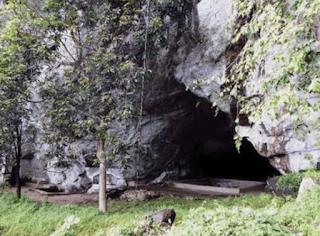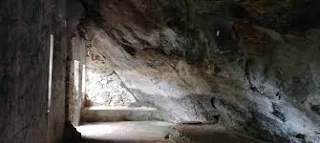Batadomba Lena, besides Pahiyangala and Beli Lena, is one of the three most important archaological sites in rock shelters where prehistoric human skeletal remnants and tools of the prehistoric Balangoda culture were excavated. Batadomba Lena is also the destination of a nice little hike in the Ratnapura region, close to Kuruwita. This article begins with a description of the hike from a touristic perspective. If you are only interested in the prehistoric findings.
The picturesque cliff of Batadomba Lena lies in a private rubber plantation in the foothills of Adam's Peak, about eight kilometers east of Kuruwita. A trip here is only worthwhile for those travelers looking for an idyllic spot off the beaten path and like a short hike.
During the rainy season, the overhanging rock of Batadomba Lena is also a waterfall. During the dry season, the stream of water in front of the cave entrance becomes increasingly sparse. But it is still humid here at any time of the year. Drops of water constantly fall across the entire width of the rock.There are several semi-caves in the rock, the largest of which is one of the important prehistoric sites in Sri Lanka and its Balangoda culture. Of course, hardly anything of the finds can be seen on site, only the excavation hole is a remnant of the archaeological survey.
Along the less steep side of the rock you can also climb to the stream and further caves above the rock face, safely, but because of the dense thicket it’s not without difficulties. The path begins to the right of the main rock face. Some of the rock shelters were apparently used as dwellings by Buddhist hermits, as so-called kutis, as is often the case in Sri Lanka,. You can recognize the former Kutis by traces of external walls.
To the left of the main rock is another group of natural caves. They are at the same height and not far away, but can only be reached via slippery boulders. You can't fall deeply here, but there is definitely a risk of breaking on’s foot. The jungle scenery is worth the little effort of having to use your hands here and there.
The footpath from the street parking lot to the main cave, however, is free of such small dares. It's only two kilometers long and the route is varied, partly under rubber trees, partly through natural forest, partly along a stream, partly with views of the Ratnapura plain. Nevertheless, this short hike is little bit difficult for an average walker. It's a slippery stairway at the beginning, it's almost always uphill, and that's in the hot and humid tropical climate. Brittle steps and roots require attention to avoid tripping.
Above all, the area is teeming with leeches. Using a repellent before starting the climb is a must. Washing with Sri Lanka's popular so-called blue soap alone does not provide sufficient protection. In addition to repellents, salt on your ankles and socks is also helpful. Leeches of this region neven bite through textiles and leave behind huge blood stains.
Since there are rubber trees planted in the area of Batadomba Lena that are regularly tapped, you shouldn't be surprised to meet locals. If you're lucky, you'll even get to know the owner of the small plantation and his son, who are very open to rare guests and happy to help you on the jungle paths.
Archaeologists unearthed an unusually large number of artifacts in the rock shelter of Batadomba Lena. Various finds of bones of early humans from the Batadomba Lena have been dated to between 31,000 and 18,000 years BP (before present), while the oldest known human bones of the so-called Balangoda people of Sri Lanka are around 37,000 years old (found in Pahiyangala). The human bones of Batadomba Lena were also examined at Cornell University in the USA.
In the Batadomba Lena, as in many other sites of the Balangoda culture, astonishingly old microliths were discovered, which in Europe are considered to be the index fossil of the Mesolithic. The Balangoda people's prey included deer, monkeys and porcupines. Snails were also collected. The food also included breadfruit. Among the finds in the Batadombalena are seeds of Artocarpus nobilis, Musa pardisiaca and Aleurites triloba. Surprisingly, shell finds in the Batadomba Cave provide evidence of an exchange with coastal inhabitants.
Homo sapiens - apart from an initial, but probably only temporary presence in Palestine - migrated through southern Asia at the earliest 80,000 years ago and at the latest 60,000 years ago, because the oldest human bone finds in Australia are 40,000 years old, but the oldest human artifacts on that continent are 60,000 years old. As at that point in time Australia was not connected to Southeast Asia by land and was not within sight of it, the early immigrants to Australia must have already had ocean-going boats. In view of this d based on discoveries of the early presence of Homo sapiens in the southeast of the Arabian Peninsula and due to the genetically proven descent of non-European people from African ancestors exclusively from the Horn of Africa region, it is most likely that this first migration of Homo sapiens led directly along the Indian Ocean, not via Palestine and the Fertile Crescent. The Homo sapiens mirating out of Africa first crossed the Bab-Al Mandab strait, which is mouth of the Red Sea near Aden, and later on might also have crossed the Strait of Hormuz at the entrance to the Persian Gulf directly. Anyway, the first arrival of Homo sapiens in today's Sri Lanka can be assumed to have taken place between 80,000 and 60,000 years ago.
This expansion of the habitat of Homo sapiens is often connected with the Toba catastrophe theory, according to which Homo sapiens almost became extinct after the eruption of the Toba volcano on Sumatra 74,000 years ago due to the subsequent climate change. But only as a result of this catastrophe new habitats might have become less dangerous for modern humans, because the Homo erectus that had previously lived there, might have been weakened by the Toba catastrophe. However, the impact of the Toba eruption - and if there was any significant change in human population at all - is still a matter of debate. Finds from Jwalapuram in southern India demonstrate the presence of Homo sapiens already prior to the Toba catastrophe and no decline in settlement density or the type of tools used for thousands of years afterwards. It’s more likely that the arrival of Homo sapiens in South Asia took place before rather than after the Toba catastrophe.
Through genetic studies, however, we know the following with greater certainty: After that first migration of the ancestors of all today's non-African people, who, as mentioned, began their conquest of the world from the Horn of Africa and via southern Asia reached Australia surprisingly soon, a second major wave of immigration from Africa to India occurred in the Paleolithic, around 40,000 years ago. This second migration of Homo sapiens led to his advance into China and also to his immigration into Europe from Central Asia. In the Indian region, this second large migrant group completely displaced the previous male population, but not the female population. This means that the new immigrants committed theft of women.










0 Comments